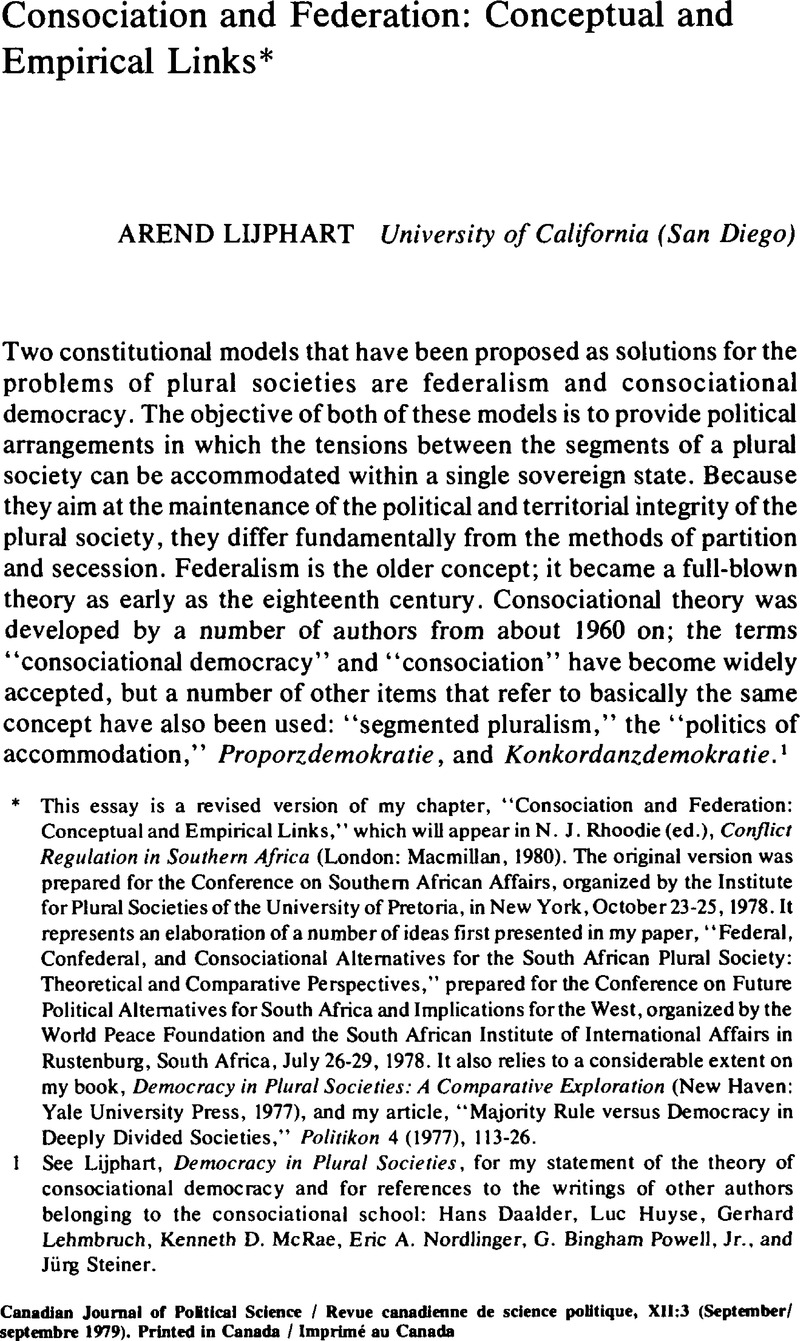Published online by Cambridge University Press: 10 November 2009

1 See Lijphart, Democracy in Plural Societies, for my statement of the theory of consociational democracy and for references to the writings of other authors belonging to the consociational school: Hans Daalder, Luc Huyse, Gerhard Lehmbruch, Kenneth D. McRae, Eric A. Nordlinger, G. Bingham Powell, Jr., and Jürg Steiner.
2 Lane, Jan-Ėrik, “Some Theoretical Notes on Institutional Autonomy,” Stalsvelenskaplig Tidskrift 4 (1977), 256–57Google Scholar.
3 Riker, William H., “Federalism,” in Greenstein, Fred I. and Polsby, Nelson W.(eds.), Handbook of Political Science, Vol. 5: Governmental Institutions and Processes (Reading: Addison-Wesley, 1975), 101Google Scholar.
4 See Elazar, Daniel J., “Federalism,” in Sills, David L. (ed.), International Encyclopedia of the Social Sciences, Vol. 5 (New York: Macmillan and Free Press, 1968), 356Google Scholar.
5 Friedrich, Carl J., Limited Government: A Comparison (Englewood Cliffs: Prentice-Hall, 1974), 55Google Scholar.
6 Herman, Valentine and Mendel, Françoise, Parliaments of the World: A Reference Compendium (London: Macmillan, 1976), 4Google Scholar. Ivo D. Duchacek calls attention to the two exceptions of federal but unicameral parliaments: those of Cameroon and Pakistan. See Duchacek, , Comparative Federalism: The Territorial Dimension of Politics (New York: Holt, Rinehart, and Winston, 1970), 248–49Google Scholar. However, Herman and Mendel describe Pakistan's legislature as bicameral, and they regard Cameroon as nonfederal.
7 Ameller, Michel, Parliaments: A Comparative Study of the Structure and Functioning of Representative Institutions in Fifty-Five Countries (London: Cassell, 1966), 5–6Google Scholar; Herman and Mendel, Parliaments of the World, 5.
8 Friedrich, Limited Government, 21. See also Duchacek, Comparative Federalism, 230–31; and Elazar, “Federalism,” 360.
9 Unfortunately, the first World Handbook does not supply comparable figures for the highly decentralized Swiss federal system, and the second World Handbook does not report similar data at all. An even more striking illustration of the link between federalism and decentralization appears when we examine the percentages of all government employees that are employed by the central government in the six countries for which the necessary figures are given in the first World Handbook: 80, 69, and 59 per cent respectively in three unitary states—France, the United Kingdom, and New Zealand—and 41, 28, and 27 percent respectively in federal West Germany, Australia, and the United States. See Russett, Bruce M. et al. , World Handbook of Political and Social Indicators (New Haven: Yale University Press, 1964), 70–71Google Scholar.
10 Livingston, William S., “A Note on the Nature of Federalism,” in Wildavsky, Aaron (ed.), American Federalism in Perspective (Boston: Little, Brown, 1967), 37Google Scholar. See also Stein, Michael B., “Federal Political Systems and Federal Societies,” World Politics 20 (1968), 721–47CrossRefGoogle Scholar.
11 Duchacek, Comparative Federalism, 250.
12 Vile, M. J. C., “Federal Theory and the ‘New Federalism,’” in Jaensch, Dean (ed.), The Politics of “New Federalism” (Adelaide: Australasian Political Studies Association, 1977), 4Google Scholar.
13 Elazar, “Federalism,” 357.
14 Friedrich, Carl J., “Corporate Federalism and Linguistic Politics,” paper presented at the Ninth World Congress of the International Political Science Association,Montreal, 1973Google Scholar. See also McRae, Kenneth D., “The Principle of Territoriality and the Principle of Personality in Multilingual States,” International Journal of the Sociology of Language, 4 (1975), 33–54Google Scholar.
15 Uustalu, Evald, The History of Estonian People (London: Boreas, 1952), 220Google Scholar.
16 Aun, Karl, “Cultural Autonomy of Ethnic Minorities in Estonia: A Model for Multicultural Society?” paper presented at the Third Conference of Baltic Studies in Scandinavia,Stockholm, 1975, 1, 11–12Google Scholar.
17 Friedrich, “Corporate Federalism and Linguistic Politics,” 9, 14.
18 Friedrich, Carl J., Trends of Federalism in Theory and Practice (New York: Praeger, 1968), 124Google Scholar.
19 Riker, “Federalism,” 107; Lijphart, “Federal, Confederal, and Consociational Alternatives,” 5 and Fig. 1.
20 Tarlton, Charles D., “Symmetry and Asymmetry as Elements of Federalism: A Theoretical Speculation,” Journal of Politics, 27 (1965), 868–69, 873CrossRefGoogle Scholar. Lawrence Mayer draws a similar contrast between “congruent” (that is, asymmetrical) and “formalistic” (that is, symmetrical) federations; see his “Federalism and Party Behavior in Australia and Canada,” Western Political Quarterly 23 (1970), 795–96CrossRefGoogle Scholar.
21 Rae, Douglas W. and Taylor, Michael, The Analysis of Political Cleavages (New Haven: Yale University Press, 1970), 22–23Google Scholar.
22 The figures are mainly based on census data, but no such data are available for the subunits in India and in semifederal Belgium. The indices for these two countries are based on the assumption that the Indian states are 80 per cent linguistically homogeneous on the average, and that Flanders and Wallonia are 95 per cent and Brussels 80 per cent linguistically homogeneous.
23 For descriptions of the federal characteristics of Belgium and the Netherlands Antilles, see Heisler, Martin O., “Managing Ethnic Conflict in Belgium,” Annals of the American Academy of Political and Social Science 433 (1977), 32–46CrossRefGoogle Scholar; Zolberg, Aristide R., “Splitting the Difference: Federalization without Federalism in Belgium,” in Esman, Milton J. (ed.), Ethnic Conflict in the Western World (Ithaca: Cornell University Press, 1977), 103–42Google Scholar; and Lijphart, Democracy in Plural Societies, 192–97, 202–06.
24 Heisler, “Managing Ethic Conflict in Belgium,” 42.